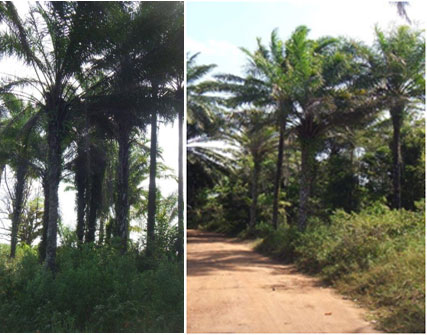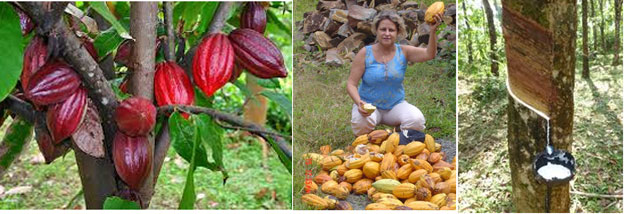We call medium life-cycle cropsthose produces that have a life span of more than two years.
The ones presented are the result of the ‘natural selection’ of the ’innumerous’ other trialsthat occurred over the 12 years of our agricultural activity. These products ‘work’ in our microclimate, are or can be economically exploited in our kind of soil, have attractive local markets, areas can be easily expanded if theyneed to reach economic volumes but can be started in small lots, with minimal investment and maintenance costs.
And last, but not least, there is enough in-house knowledge and experience to husband these kind of crops. Such knowledge is not trivial: there are many other interesting crops that could be considered but new cultures must be studied, require experimentation, observation for at least a year or two, etc., before reaching a reasonably solid degree of their real potential of production and market viability.
For example, we already know what not to grow (with a minimal business objective) in this region: banana, pineapple, tapioca, cloves, are no, no, cultures – just to name a few with which we have experimented and concludedthat they are economically not viable. It was not only economic reasonsthat led us to this conclusion: we looked at the climate, production, water needs, pests, processes, after harvest processing, market access, etc., just to start with. Those listed below passed all the above tests.We shall look at these again, in the future, to select those crops that could be added to the limes and coffee…
Theproduces that we shall consider in the future are:

- Pawpaw
- Passion fruit
- Watermelons and melons for export
- Piassava
- Ornamental flowers
- Eucalyptus
- Cacao
- Acai
- Cloves
- Dendê
- Rubber trees
Our crops: the medium life-cycle produce

- Eucaliptus
- Cacau
- Açaí
- Dendê
- Seringa
One could, correctly criticize our definition of medium cycle crops as ‘unique’. It is not only based on rational elements but also on psychological, social and historical factors of the area. Perhaps these crops should not be divided into two groups… maybe the two cycles should be combined as one and there should be more of a critical analysis. However, it works for us but we are not averse to change if necessary.
The eucalyptus business

When we planted the first 10 hectares of coffee, we became aware that drying it would be a major procedure forthis produce.This would allow us to stock it for long periods (even as long as 12 to 24 months), and sell it when theprice was high… if cash flowhad not been an issue.
At the time (2007), we were contemplating a sophisticated processing plant, somewhat expensive, but we discovered a large amount of wood had to be used for the process. We feared we would have to cut trees from the forest to match the demand for fuel, which would be anunconscionable idea! Nonetheless, we went ahead and planted 35 hectares of eucalyptus, just to be sure.
The eucalyptus business

Then our Doctor Matiello, recognized internationally as the absolute authority in coffee (the ‘pope’ of coffee), in partnership with other researchers, designed a new way to dry coffee with a kiln which would be cheap to construct and use minimal fuel. We immediately changed plans, constructing 3 kilns and, in 2008, we had the whole process ready for that year’s crop. Thenet result was that instead of 30 tons per harvest, we needed only three! But the trees were already cut so… now we have 35 hectares of eucalyptus to sell… andmaybe we can even expand and include this crop!
The cacao business

When we bought the PeralbaFloresta group of farms, we foundthat there were already three existing hectares of cacao – abandoned, miserable, but alive. Two years later, in 2009, they began producing 35 arrobas per hectare. We were so proud that we started scouting for other areas and we planted approximately another 10-12 hectares, in remote sites of the farm.
Then we discovered that the work force costs to maintain such crops, were prohibitive. Today, we still have about 9 hectares producing and the fruit isharvested by our faithful Louro, 50% for him and 50% for us. Not much, but the cacao is still there.
We learnt though that in the last 15 years, cacao has been grown in husbandry with seringa, the rubber tree. This is where we shall go next, as soon as the lime business consolidates.
The acai crop
 In 2010 we planted two hectares to experiment with his crop, near the Yellow House, more as a curiosity than a real intention. The growth was so energetic that we planted another couple of hectares in another wet area, far away, and left it to grow unattended. Same result: exceptional growth, total resistance to pests, no fertilizer, no husbandry, nothing. As this palm grows in very humid environments, of which we have plenty around the farm, why not fill those remote areas with this crop? We estimated that we might fill 30 or 40 hectares in various sites. Harvesting could be done in partnership with some local, a la piassava, and costs would be kept at a minimum. Several smashers confirmed their interest in buying all we could produce… small income in comparison with limes, but nice to have, without all the headaches of a full plantation of this produce. As soon as we get the limes stable, we shall revisit this crop. 2019 would be about the right time for this.
In 2010 we planted two hectares to experiment with his crop, near the Yellow House, more as a curiosity than a real intention. The growth was so energetic that we planted another couple of hectares in another wet area, far away, and left it to grow unattended. Same result: exceptional growth, total resistance to pests, no fertilizer, no husbandry, nothing. As this palm grows in very humid environments, of which we have plenty around the farm, why not fill those remote areas with this crop? We estimated that we might fill 30 or 40 hectares in various sites. Harvesting could be done in partnership with some local, a la piassava, and costs would be kept at a minimum. Several smashers confirmed their interest in buying all we could produce… small income in comparison with limes, but nice to have, without all the headaches of a full plantation of this produce. As soon as we get the limes stable, we shall revisit this crop. 2019 would be about the right time for this.
The dendécrop
The dendê oil is an edible vegetable oil, derived from the monocarp (reddish pulp) of the fruit of the oil palms, primarily the African oil palm Elaeisguineensis.
This palm oil is a common cooking ingredient in the tropical belt of Africa, Southeast Asia and parts of Brazil. Its use in the commercial food industry in other parts of the world is widespread, because of its lower cost and the high oxidative stability (saturation) of the refined product when used for frying.
Most recently, it has been used in producing diesel oil for cars and trucks, bio-diesel, and is sold directly to the public via distributors like Shell and Petrobras.
Dendé needs vast areas to become economically viable and, for this reason, it will remain a minor/social crop to be harvested by our loyal Louro and sold to the local smasher. He is a direct descendent of freed slaves and runs an extended family in a nearby area called Mata Escura. He is a neighbour of great value and presence, for whom we have great respect and affection. He and some members of his family (which includes his mother of 75 years of age) work at various times, under contract, in our coffee plantation. Ourdendé is totally harvested by him and we take a small cut to establish ownership. The rest is all for him.
Let’s call this our social investment in a precious neighbour.

The natural rubber crop (in husbandry with cacao)

This was one of the first crops with which we experimented. Itrelies on the vicinity of Michelin, the tyre company, while a family member was the production director. We were allocated 30 hectares,but planted only 2,4, just to experiment. We discussed at length whether to plant in husbandry with cacao, but eventually decided that the experiment had to be seen isolation. Only in this way, would we be able to gauge the real needs and difficulties of such a crop.

It went well. However, we got distracted by the cattle business and later by the lime business. The site was eight km from the Yellow House and the people we recruited from the south, experienced in rubber plantation,were not happy to live in the primitive situation of the rubber farm (no electricity, no way to link it, no running water, no television, no fridge, difficult transport to school, just to start with…). It was a no go situation. When the trees started to produce, people left. We had to give up this project, which was very sad.

Since then… the road reaches the house, electricity is nearby, the school bus picks up kids from farms further away… it became livable, too late though.
The concept was a success: perfect climate, perfect soil, perfect area. Whatwe need now is enthusiasm and youth to reactivate this project, start anew, with cacao en suite, a new house with all amenities… and 30 to 50 hectares to make it sustainable.
We are ready… as soon as the limes consolidate…

.jpg)
.jpg)
.jpg)
.jpg)
.jpg)
.jpg)
.jpg)
.jpg)
.jpg)
.jpg)
.jpg)
.jpg)
.jpg)
.jpg)
.jpg)
.jpg)
.jpg)
.jpg)
.jpg)
.jpg)